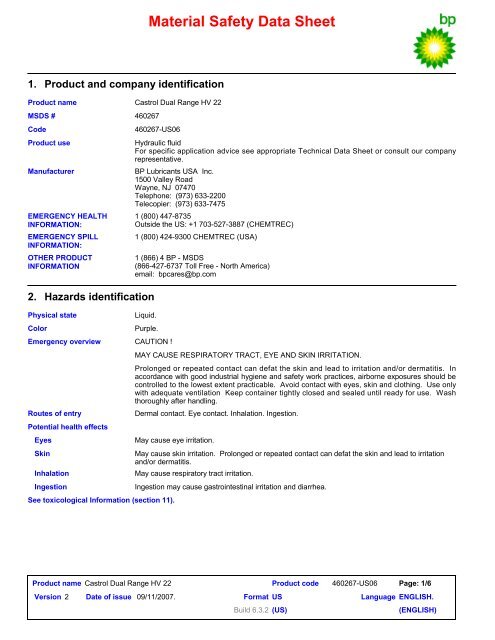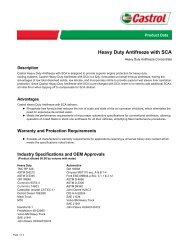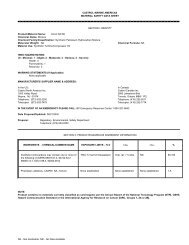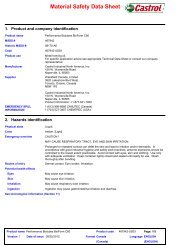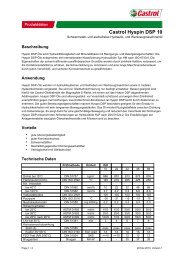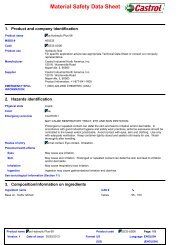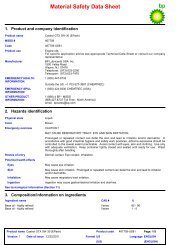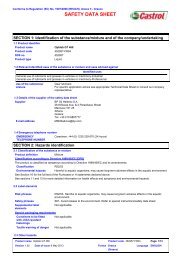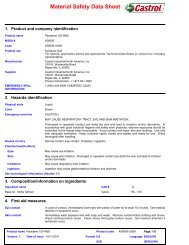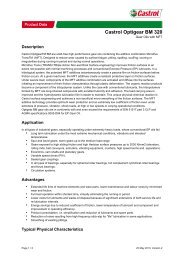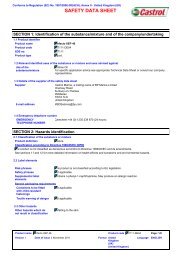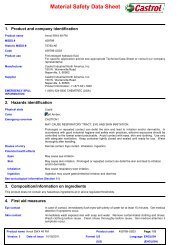017198US-Lubes Americas-BP (Wayne, NJ US). - Castrol
017198US-Lubes Americas-BP (Wayne, NJ US). - Castrol
017198US-Lubes Americas-BP (Wayne, NJ US). - Castrol
- No tags were found...
You also want an ePaper? Increase the reach of your titles
YUMPU automatically turns print PDFs into web optimized ePapers that Google loves.
Material Safety Data Sheet1. Product and company identificationProduct name <strong>Castrol</strong> Dual Range HV 22MSDS # 460267CodeProduct useManufacturerEMERGENCY HEALTHINFORMATION:EMERGENCY SPILLINFORMATION:OTHER PRODUCTINFORMATION2. Hazards identificationPhysical stateColor460267-<strong>US</strong>06Hydraulic fluidFor specific application advice see appropriate Technical Data Sheet or consult our companyrepresentative.<strong>BP</strong> Lubricants <strong>US</strong>A Inc.1500 Valley Road<strong>Wayne</strong>, <strong>NJ</strong> 07470Telephone: (973) 633-2200Telecopier: (973) 633-74751 (800) 447-8735Outside the <strong>US</strong>: +1 703-527-3887 (CHEMTREC)1 (800) 424-9300 CHEMTREC (<strong>US</strong>A)1 (866) 4 <strong>BP</strong> - MSDS(866-427-6737 Toll Free - North America)email: bpcares@bp.comLiquid.Purple.Emergency overview CAUTION !Routes of entryPotential health effectsEyesSkinInhalationIngestionMAY CA<strong>US</strong>E RESPIRATORY TRACT, EYE AND SKIN IRRITATION.Prolonged or repeated contact can defat the skin and lead to irritation and/or dermatitis. Inaccordance with good industrial hygiene and safety work practices, airborne exposures should becontrolled to the lowest extent practicable. Avoid contact with eyes, skin and clothing. Use onlywith adequate ventilation Keep container tightly closed and sealed until ready for use. Washthoroughly after handling.Dermal contact. Eye contact. Inhalation. Ingestion.May cause eye irritation.See toxicological Information (section 11).May cause skin irritation. Prolonged or repeated contact can defat the skin and lead to irritationand/or dermatitis.May cause respiratory tract irritation.Ingestion may cause gastrointestinal irritation and diarrhea.Product name <strong>Castrol</strong> Dual Range HV 22Product code 460267-<strong>US</strong>06Version 2 Date of issue 09/11/2007.Format <strong>US</strong>LanguageBuild 6.3.2 (<strong>US</strong>)Page: 1/6ENGLISH.(ENGLISH)
3. Composition/information on ingredientsIngredient name CAS # %Base oil - highly refined Mixture 0 - 1004. First aid measuresEye contactSkin contactInhalationIngestionNotes to physicianIn case of contact, immediately flush eyes with plenty of water for at least 15 minutes. Get medicalattention if symptoms occur.Immediately wash exposed skin with soap and water. Remove contaminated clothing and shoes.Get medical attention if symptoms occur. Wash clothing before reuse. Thoroughly clean shoesbefore reuse.If inhaled, remove to fresh air. Get medical attention if symptoms occur.Get medical attention if symptoms occur. Do NOT induce vomiting unless directed to do so bymedical personnel. Never give anything by mouth to an unconscious person. If large quantities ofthis material are swallowed, call a physician immediately.Note: High Pressure ApplicationsInjections through the skin resulting from contact with the product at high pressure constitute amajor medical emergency. Injuries may not appear serious at first but within a few hours tissuebecomes swollen, discoloured and extremely painful with extensive subcutaneous necrosis.Surgical exploration should be undertaken without delay. Thorough and extensive debridement ofthe wound and underlying tissue is necessary to minimise tissue loss and prevent or limitpermanent damage. Note that high pressure may force the product considerable distances alongtissue planes.5. Fire-fighting measuresFlash pointFire/explosion hazardsExtinguishing mediaSuitableNot suitableFire-fighting proceduresHazardous combustionproductsProtective clothing (fire)Open cup: 176°C (348.8°F) [Cleveland.]In a fire or if heated, a pressure increase will occur and the container may burst.Use an extinguishing agent suitable for surrounding fires.Do not use water jet.Promptly isolate the scene by removing all persons from the vicinity of the incident if there is a fire.No action shall be taken involving any personal risk or without suitable training.Decomposition products may include the following materials:carbon oxides (CO, CO2) (carbon monoxide, carbon dioxide)Fire fighters should wear appropriate protective equipment and self-contained breathing apparatus(SCBA) with a full facepiece operated in positive pressure mode.6. Accidental release measuresPersonal precautionsEnvironmentalprecautionsMethods and materials for containment and clean-upNo action shall be taken involving any personal risk or without suitable training. Keep unnecessaryand unprotected personnel from entering. Do not touch or walk through spilled material. Inaccordance with good industrial hygiene and safety work practices, airborne exposures should becontrolled to the lowest extent practicable. Provide adequate ventilation. Wear appropriaterespirator when ventilation is inadequate. Put on appropriate personal protective equipment (seeSection 8).Avoid dispersal of spilled material and runoff and contact with soil, waterways, drains and sewers.Inform the relevant authorities if the product has caused environmental pollution (sewers,waterways, soil or air).Product name <strong>Castrol</strong> Dual Range HV 22Product code 460267-<strong>US</strong>06Version 2 Date of issue 09/11/2007.Format <strong>US</strong>LanguageBuild 6.3.2 (<strong>US</strong>)Page: 2/6ENGLISH.(ENGLISH)
Large spillSmall spillStop leak if without risk. Move containers from spill area. Approach release from upwind. Prevententry into sewers, water courses, basements or confined areas. Wash spillages into an effluenttreatment plant or proceed as follows. Contain and collect spillage with non-combustible absorbentmaterials, e.g. sand, earth, vermiculite, diatomaceous earth, and place in container for disposalaccording to local regulations (see section 13). Dispose of via a licensed waste disposalcontractor. Contaminated absorbent material may pose the same hazard as the spilled product.Note: see section 1 for emergency contact information and section 13 for waste disposal.Stop leak if without risk. Move containers from spill area. Dilute with water and mop up, or absorbwith an inert dry material and place in an appropriate waste disposal container. Dispose of via alicensed waste disposal contractor.7. Handling and storageHandlingStorageOther informationPut on appropriate personal protective equipment (see Section 8). Workers should wash handsand face before eating, drinking and smoking. Do not breathe vapor or mist. Do not ingest. Avoidcontact with eyes, skin and clothing. Use only with adequate ventilation Wear appropriaterespirator when ventilation is inadequate.Store in accordance with local regulations. Store away from direct sunlight in a dry, cool and wellventilatedarea, away from incompatible materials (see section 10). Keep container tightly closedand sealed until ready for use. Containers that are opened must be carefully resealed and keptupright to prevent leakage. Do not store in unlabeled containers. Use appropriate containment toavoid environmental contamination.Sulfur compounds in this material may decompose when heated to release hydrogen sulfide gaswhich may accumulate to potentially lethal concentrations in enclosed air spaces. Vaporconcentrations of hydrogen sulfide above 50 ppm, or prolonged exposure at lower concentrations,may saturate human odor perceptions so that the smell of gas may not be apparent. Exposure toconcentrations of hydrogen sulfide vapor above 500 ppm may cause rapid death. Do not rely onthe sense of smell to detect hydrogen sulfide.8. Exposure controls/personal protectionOccupational exposure limitsIngredient nameBase oil - highly refinedHydrotreated petroleum distillateBase oil - highly refinedHighly refined base oilSome states may enforce more stringent exposure limits.Occupational exposure limitsACGIH (United States).TWA: 5 mg/m 3 8 hour(s). Form: Oil mist, mineralSTEL: 10 mg/m 3 15 minute(s). Form: Oil mist, mineralOSHA (United States).TWA: 5 mg/m 3 8 hour(s). Form: Oil mist, mineralACGIH (United States).STEL: 10 mg/m 3 15 minute(s). Form: Oil mist, mineralTWA: 5 mg/m 3 8 hour(s). Form: Oil mist, mineralOSHA (United States).TWA: 5 mg/m 3 8 hour(s). Form: Oil mist, mineralACGIH (United States).STEL: 10 mg/m 3 15 minute(s). Form: Oil mist, mineralTWA: 5 mg/m 3 8 hour(s). Form: Oil mist, mineralOSHA (United States).TWA: 5 mg/m 3 8 hour(s). Form: Oil mist, mineralACGIH (United States).STEL: 10 mg/m 3 15 minute(s). Form: Oil mist, mineralTWA: 5 mg/m 3 8 hour(s). Form: Oil mist, mineralOSHA (United States).TWA: 5 mg/m 3 8 hour(s). Form: Oil mist, mineralWhile specific OELs for certain components may be shown in this section, other components may be present in any mist, vapor ordust produced. Therefore, the specific OELs may not be applicable to the product as a whole and are provided for guidance only.Control MeasuresUse only with adequate ventilation If user operations generate dust, fumes, vapor or mist, useprocess enclosures, local exhaust ventilation, or other engineering controls to keep workerexposure to airborne contaminants below any recommended or statutory limits.Product name <strong>Castrol</strong> Dual Range HV 22Product code 460267-<strong>US</strong>06Version 2 Date of issue 09/11/2007.Format <strong>US</strong>LanguageBuild 6.3.2 (<strong>US</strong>)Page: 3/6ENGLISH.(ENGLISH)
Hygiene measuresPersonal protectionEyesSkin and bodyRespiratoryHandsWash hands, forearms and face thoroughly after handling chemical products, before eating,smoking and using the lavatory and at the end of the working period. Appropriate techniquesshould be used to remove potentially contaminated clothing. Wash contaminated clothing beforereusing.Avoid contact with eyes. Safety glasses with side shields or chemical goggles.Avoid contact with skin and clothing. Wear suitable protective clothing.Use adequate ventilation. In accordance with good industrial hygiene and safety work practices,airborne exposures should be controlled to the lowest extent practicable.The correct choice of protective gloves depends upon the chemicals being handled, the conditionsof work and use, and the condition of the gloves (even the best chemically resistant glove willbreak down after repeated chemical exposures). Most gloves provide only a short time ofprotection before they must be discarded and replaced. Because specific work environments andmaterial handling practices vary, safety procedures should be developed for each intendedapplication. Gloves should therefore be chosen in consultation with the supplier/manufacturer andwith a full assessment of the working conditions.Consult your supervisor or S.O.P. for special handling directions9.Physical and chemical propertiesPhysical stateColorFlash pointLiquid.Purple.Specific gravity 0.847Open cup: 176°C (348.8°F) [Cleveland.]Viscosity Kinematic: 20.89 mm 2 /s (20.89 cSt) at 40°CKinematic: 4.8 mm 2 /s (4.8 cSt) at 100°CSolubility10. Stability and reactivityInsoluble in water.Stability and reactivityConditions to avoidIncompatibility withvarious substancesHazardous decompositionproductsHazardous polymerizationThe product is stable. Under normal conditions of storage and use, hazardous polymerization willnot occur.Keep away from heat, sparks and flame.Reactive or incompatible with the following materials: oxidizing materials.Under normal conditions of storage and use, hazardous decomposition products should not beproduced.Hydrogen Sulfide (H2S)Will not occur.11. Toxicological informationOther informationPotential chronic health effectsCarcinogenicityNo known significant effects or critical hazards.Product name <strong>Castrol</strong> Dual Range HV 22Product code 460267-<strong>US</strong>06Version 2 Date of issue 09/11/2007.Format <strong>US</strong>LanguageBuild 6.3.2 (<strong>US</strong>)Page: 4/6ENGLISH.(ENGLISH)
12. Ecological informationNo testing has been performed by the manufacturer.13. Disposal considerationsWaste informationThe generation of waste should be avoided or minimised wherever possible. Dispose of surplusand non-recyclable products via a licensed waste disposal contractor. Disposal of this product,solutions and any by-products should at all times comply with the requirements of environmentalprotection and waste disposal legislation and any regional local authority requirements. Avoiddispersal of spilled material and runoff and contact with soil, waterways, drains and sewers.NOTE: The generator of waste has the responsibility for proper waste identification (based on characteristic(s) or listing),transportation and disposal14. Transport informationInternational transport regulationsRegulatoryinformationUNnumberProper shipping name Class Packing group Additional informationDOTClassificationNotregulated.- -- -TDGClassificationNotregulated.----IMDGClassificationNotregulated-- --IATA/ICAOClassificationNotregulated.- - - -15. Regulatory informationU.S. Federal regulationsSARA 313Form R - ReportingrequirementsSupplier notificationCERCLA Sections102a/103 HazardousSubstances (40 CFRPart 302.4):State regulationsMassachusettsSubstancesUnited States inventory (TSCA 8b): All components are listed or exempted.TSCA 12(b) one time export: NaphthaleneSARA 302/304/311/312 extremely hazardous substances: No products were found.SARA 302/304 emergency planning and notification: No products were found.SARA 302/304/311/312 hazardous chemicals: No products were found.SARA 311/312 MSDS distribution - chemical inventory - hazard identification: <strong>Castrol</strong> DualRange HV 22 : Immediate (Acute) Health HazardThis product does not contain any hazardous ingredients at or above regulated thresholds.This product does not contain any hazardous ingredients at or above regulated thresholds.CERCLA: Hazardous substances.: Zinc dialkyl dithiophosphate; Ethyl acrylate: 1000 lbs. (453.6kg); Naphthalene: 100 lbs. (45.36 kg);Massachusetts RTK: None of the components are listed.Product name <strong>Castrol</strong> Dual Range HV 22Product code 460267-<strong>US</strong>06Version 2 Date of issue 09/11/2007.Format <strong>US</strong>LanguageBuild 6.3.2 (<strong>US</strong>)Page: 5/6ENGLISH.(ENGLISH)
New Jersey HazardousSubstancesPennsylvania RTKHazardous SubstancesCalifornia Prop. 65InventoriesNew Jersey Hazardous Substances: The following components are listed: Oil mist, mineral(white mineral oil)Pennsylvania RTK: None of the components are listed.WARNING: This product contains a chemical known to the State of California to cause cancer.Naphthalene; Ethyl acrylateCanada inventory: All components are listed or exempted.Europe inventory: All components are listed or exempted.Australia inventory (AICS): All components are listed or exempted.China inventory (IECSC): All components are listed or exempted.Japan inventory (ENCS): At least one component is not listed.Korea inventory (KECI): All components are listed or exempted.Philippines inventory (PICCS): All components are listed or exempted.16. Other informationLabel requirements CAUTION !HMIS® Rating :HistoryDate of issue 09/11/2007.Date of previous issuePrepared byNotice to readerMAY CA<strong>US</strong>E RESPIRATORY TRACT, EYE AND SKIN IRRITATION.Health - 1FlammabilityPhysical10HazardPersonal XprotectionNo Previous Validation.Product StewardshipNational Fire1ProtectionFire hazardAssociation (U.S.A.) Health 1 0 InstabilitySpecific hazardNOTICE : This Material Safety Data Sheet is based upon data considered to be accurate at the time of its preparation. Despite ourefforts, it may not be up to date or applicable to the circumstances of any particular case. We are not responsible for any damage orinjury resulting from abnormal use, from any failure to follow appropriate practices or from hazards inherent in the nature of theproduct.Product name <strong>Castrol</strong> Dual Range HV 22Product code 460267-<strong>US</strong>06Version 2 Date of issue 09/11/2007.Format <strong>US</strong>LanguageBuild 6.3.2 (<strong>US</strong>)Page: 6/6ENGLISH.(ENGLISH)


